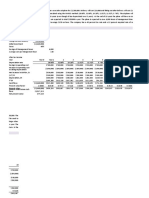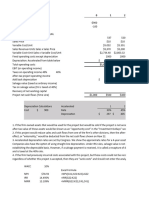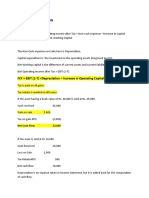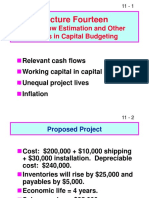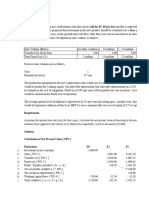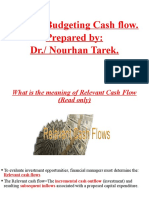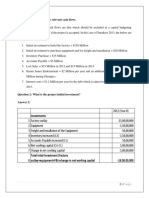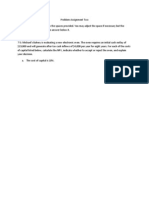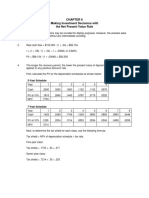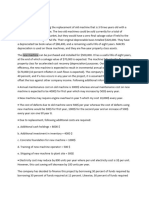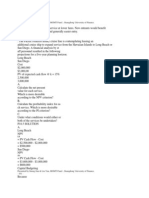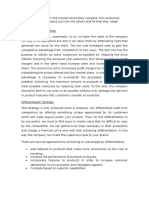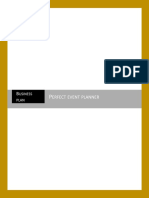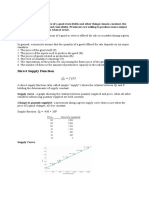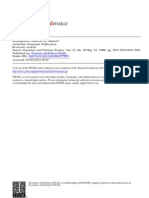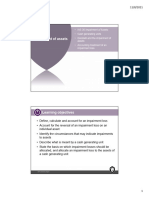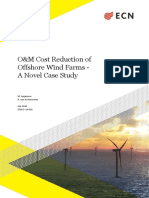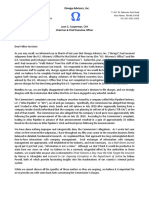Chapter 3 page 48/49 3.
2 The Replacement Problem
Quantum Systems' Investment in a New Extrusion Press Info given: Old Machine Cost of machine $ 1,000,000 Development cost SL depreciation 10 yrs Annual deprec charge 100,000 Depreciation value (current bk value) 500,000 Salvage value ? Marginal tax rate 35% Additional sales New increase in working capital New Machine 2,000,000 750,000 5 yrs 300,000 cost - salvage/life 500,000 35% 150,000 45,000
1st: Estimate the initial investment: (the project's net cash outlay) consists of 4 separate items: 1). The cost of acquiring and placing into service the necessary assets 2). The necessary increase in working capital 3). The net proceeds from the sale of existing assets in the case of replacement decision 4). The tax affects associated with the sale of existing assets and their replacement with new assets Estimating 3 & 4: 1). The asset is sold for its book value 2). The assets is sold for < book value 3). The asset is sold for > book value but less than initial purchase price 4). The asset is sold for more than its original purchase price pg 51 Exhibit 3.3 Initial cost of New Extrusion Press: 4 scenarios, Case 1 Cost of new machine $ 2,000,000 $ + increase in working capital 45,000 - sale price of old machine (pg 50 of text) 500,000 = pretax investment $ 1,545,000 $ + tax on proceeds of old machine = initial cost of new machine $ 1,545,000 $
2 2,000,000 $ 45,000 400,000 1,645,000 $ (35,000) 1,610,000 $
3 2,000,000 $ 45,000 700,000 1,345,000 $ 70,000 1,415,000 $
4 2,000,000 45,000 1,100,000 945,000 210,000 100K over cost, plus 500K over book value 1,155,000
pg 51 Exhibit 3.4 Initial cost of New Extrusion Press with an ITC: 4 scenarios Case 1 2 = initial cost of new machine with no ITC $ 1,545,000 $ 1,610,000 $ - investment tax credit @ 10% of cost 200,000 200,000 = initial cost of new machine with ITC $ 1,345,000 $ 1,410,000 $
3 1,415,000 $ 200,000 1,215,000 $
4 1,155,000 200,000 955,000
�side note pg. 52 - example of NPV with multi year investment; 10% discount rate Stretching the investment reduces the PV of initial cost, but also delays receipts of project CF's Year Cost Discount rate @ 10% PV PV factor 0 18 1
18.0
1 7
(1 + .10) 6.4
2 20
(1 + .10)2 16.5
45
using excel function NPV $40.91
40.9 Total PV
0.909
0.826
Estimating Operating Cash Flows Incremental Operating Cash Flow =
3.1 pg. 52/53
Change in: [After tax income + Depre - working capital]
Typically start with a projected income statement Develop an income statement (pg. 53) Sales increase 150,000 Reduce annual operating expenses 180,000 Increase in depreciation 300,000 Before new Press After new Press Increments Cash Flow Sales $ 5,000,000 $ 5,150,000 $ 150,000 $ 150,000 Costs 4,000,000 3,820,000 (180,000) 180,000 Depreciation 500,000 800,000 300,000 PBT 500,000 530,000 30,000 Tx @ 35% 175,000 185,500 10,500 (10,500) Profit After Tax 325,000 344,500 19,500 Depreciation 500,000 800,000 300,000 Cash Flow $ 825,000 $ 1,144,500 $ 319,500 $ 319,500
higher revenue lower cost non-cash charge, but affects income, and thus taxes higher tax
side note RE: depre Depre is a non-cash charge, only significance is it can reduce or shield taxable income, and thus reduce taxes Example showing how the depreciation can affect Depreciation affect on cash flow
pg. 54, exhibit 3.5 year by year depreciation tax shield under MACRS
Year 1 2 3 4 5 6 Totals Depre Base (cost of new machine) $ 2,000,000 $ 2,000,000 $ 2,000,000 $ 2,000,000 $ 2,000,000 $ 2,000,000 Depre Factor 0.2 0.32 0.192 0.1152 0.1152 0.0576 Depre write off 400,000 640,000 384,000 230,400 230,400 115,200 2,000,000 Marginal tax rate 0.35 0.35 0.35 0.35 0.35 0.35 0.35 Depre Tax Shield 140,000 224,000 134,400 80,640 80,640 40,320 700,000
�Year 1 2 3 4 5 6 Totals
Depreciation Tax Shield 140,000 224,000 134,400 80,640 80,640 40,320 700,000
Lost Deprec write off 35,000 35,000 35,000 35,000 35,000
Incremental Tax Shield 105,000 189,000 99,400 45,640 45,640 40,320 525,000
pg. 55 exhibit 3.6 Calculation of incremental operating cash flows for Extrusion Press Incremental Revenues & cost reduction (after tax) 214,500 214,500 214,500 214,500 214,500 +Incremental Depre Tax Shield 105,000 189,000 99,400 45,640 45,640 40,320 = Incremental Operating Cash Flow 319,500 403,500 313,900 260,140 260,140 40,320
Year 1 2 3 4 5 6
(150,000 +180,000) x (1-.35) sls incr, cost savngs
Estimating the Terminal Value Salvage value less any taxes owed on the sale In general, the terminal value = the PV of the future cash flows generated by the asset whether it be the scrap value of the equipment or the revenue produced by the product In addiiton, any working capital investment would be recaptured at the termination of the project. In this case 45,000 line 31 above, working capital recaptured Example: assume salvage value of the new press at the end of the 5 yr period is estimated at Book value taxable gain on asset taxes on gain @35% working capital recapture Total terminal value $
500,000 assumed 115,200 cell D86 from above 384,800 134,680 365,320 salabage value less the taxes on the gain (500,000-134,680) 45,000 410,320
Another way of incorporating the terminal value in a project analysis is to find the break even terminal value that would yield a -0- NPV Example (pg 56) Required return 12% Life 10 yrs Terminal value of 0 H = project NPV with -0- terminal value
�assume H = 350,000 Using formula: equation 3.2 TERM* = -H (1 + k) -350,000(1+.12)10 350000 3.10585 1,087,046.87
n
1.12
3.105848208 raise to the power of 10
Calculating the Project's NPV pg 57, exhibit 3.7
Year 0 1 2 3 4 5 Total
+ Present Value Cash Flow Factor (@15%) (1,415,000) 1 319,500 0.8696 403,500 0.7561 313,900 0.6575 260,140 0.5718 260,140 0.4972
= Present Value (1,415,000) using case 3 from exhibit 3.3 above 277,826 taking CF's from exhibit 3.6 above 305,104 206,394 148,736 129,336 (347,604) From equation 3.2
3.3 New Product Introduction Decision estimates of cash flows have high degree of uncertainty 1. Start with sales forecast pg. 58, exhibit 3.8 Year Sales Operating Expenses Product promotion Depreciation PBT Taxes @ 35% Profit after taxes Level of working capital 0 1 500 800 1,000 1,000 (2,300) (805) (1,495) 250 2 5,500 3,410 1,000 1,090 382 709 660 3 8,000 4,960 1,000 2,040 714 1,326 960 4 14,000 8,680 1,000 4,320 1,512 2,808 1,680 5 7,000 4,340 1,000 1,660 581 1,079 840 6 4,000 2,480 1,000 520 182 338 480
3,000 (3,000) (1,050) (1,950)
2. The capital investment needed to satisfy the product demand 3. The project's working capital needs 4. The accounting based financial forecast can then be used to identify relevant cash flows & calculate the project's NPV
pg. 58, exhibit 3.9 Year Capital Equipment Profit after tax + depre Working capital Total cash flow PV @ 20%
�0 1 2 3 4 5 6 7
(6,000)
(1,950) (495) 1,709 2,326 3,808 2,079 1,338
650
(250) (410) (300) (720) 840 360 480 NPV =
(7,950) (745) 1,299 2,026 3,088 2,919 1,698 1,130
(7,950) (621) 902 1,172 1,489 1,173 569 315 (2,950) added PV's separately calculated (2,950) using excel for all values at once, less initial investment
Estimating Terminal Values for New Product Introductions Variation of the constant dividend growth model can be used to estimate a project's terminal value Equ 3.3
TVn = CFn + 1 k-g
pg. 60 exhibit 3.10
Year Sales COGS SG&A exp. Depreciation PBT Taxes @ 35% Profit after taxes Level of working capital 0 1 2,500 1,625 3,000 750 (2,875) (1,006) (1,869) 750 2 10,000 6,500 3,000 750 (250) (88) (163) 3,000 3 16,500 10,725 3,000 750 2,025 709 1,316 4,950 4 21,000 13,650 3,000 750 3,600 1,260 2,340 6,300 5 23,000 14,950 3,000 0 5,050 1,768 3,283 6,900 6 25,000 16,250 3,000 0 5,750 2,013 3,738 7,500
3,000 (3,000) (1,050) (1,950)
pg. 61 exhibit 3.11 Summary of cash flows for new product introduction Profit after tax Year Capital Equipment + deprec 0 (3,000) (1,950) 1 (1,119) 2 588 3 2,066 4 3,090 5 3,283 6 3,738
Working Capital Total Cash Flow 0 (4,950) (750) (1,869) (2,250) (1,663) (1,950) 116 (1,350) 1,740 (600) 2,683 (600) 3,138 NPV = NPV =
PV @ 24% (4,950) (1,507) (1,081) 61 736 915 863 (4,963) adding ea. NPV together ($4,963) using excel to calculate NPV all at once
�Assume CF in year 6 of will grow at 5% indefinitely using equation 3.3 Terminal Value as of yr 6:
3,138
3,138,000 0.24 - 0.05
3,138,000 $ 0.19
16,515,789
TVn = CFn + 1 k-g
Discount the terminal value back to the present at 24% required rate of return yields:
pg. 61, exhibit 3.12 Various terminal values and project NPV's for various growth rates; a sensitivity analysis Project NPV (Net PV of term value with proj NPV (853) using excel: Rate: 24%, 6 periods, 0 pmt, FV = 14,943 (647) (420) (168) 115 432
Growth Rate terminal Value 0.03 14,943 0.04 15,690 0.05 16,516 0.06 17,433 0.07 18,459 0.08 19,613
PV of Terminal Value 4,111 4,316 4,543 4,796 5,078 5,395
�pg. 65-sample problem Info: Purchase perice of new equipment (FMC); SL depre, 5 yr life
Specialty Steel Products (SSP)
$ old 1,700,000 $ 5 40%
Sales $ Time period PBT & before depre margin on sales Working capital requirements (% of sales) reduced OH costs over next 5 yrs Old machine purchase price, purchased 3 yrs ago, depre SL over 5 yrs 1,000,000 Sale price of equipment today: if sold 300,000 Tax rate Cost of Capital for FMC Cost of Capital for company (SSP) Risk free interest rate ITC of 10% of purchase price of the FMC Working capital will be recaptured at the end of 5 years
1,200,000 new 1,800,000 5 years 40% 25% 90,000 per year
240,000 diff $ 100,000 increase in sales 40,000
200,000 900,000 34% 10.7% 14% 8% 10% 0.107
a). What is net investment required in the FMC?, assume -0- salvage value for both pieces of equipment. Net Investment: Cost of the equipment less: ITC less: Sales price less: tax benefit add: working capital Net Investment $ 1,200,000 120,000 300,000 34,000 add the tax benefit 25,000 771,000 a).
771,000
Tax benefit calc: Cost depreciation (3 yrs) 5yr, SL
1,000,000 600,000
�NBV Sale price diff Tax rate @ 34%
400,000 300,000 sold at a loss (100,000) (34,000) tax benefit
b). Operating Cash Flows for next 5 years 0 Incremental profit ($) + cost savings - Incremental depreciation = EBIT - tax (@35%) = Profit after tax + Incremental depreciation + working capital recapture = cash flow $ 1 40,000 $ 90,000 40,000 90,000 30,600 59,400 40,000 99,400 $ 2 40,000 $ 90,000 40,000 90,000 30,600 59,400 40,000 99,400 $ 3 40,000 $ 90,000 240,000 (110,000) (37,400) (72,600) 240,000 167,400 $ 4 40,000 $ 90,000 240,000 (110,000) (37,400) (72,600) 240,000 167,400 $ 5 40,000 90,000 240,000 (110,000) (37,400) (72,600) 240,000 25,000 192,400
(1,200,000) $
Incremental depreciation calc: Cost
1,000,000 $ Old Machine D/E per year, 3 yrs old 200,000
1,200,000
5 yr life, SL
New Machine D/E per year Incremental 240,000 40,000
c). Based on the info given, should SSP replace its current equipment with the new system? Calculate the NPV 0 (771,000) 1 99,400 2 99,400 3 167,400 4 167,400
�5 NPV = Negative NPV, so project should be rejected.
192,400 ($249,488) (249,488) 0
d). What questions might you raise about some of the assumptions in this capital request? 1). Sales if they don't invest remain the same; would this necessarily be true? Factor a possible decline in the forecast. 2). Margin ion the sales also assumed to stay the same; would this necessarily be true? Factor a possible decline in the forecast. 3). No account for the inflation rate; factor in a rise in sales and costs to account for the inflation rate. 4). If the new machine is purchased, then w/c may be high, as increased quality output, should lead to lower inventory in WIP. Things will be done right the first time, reducing WIP.




